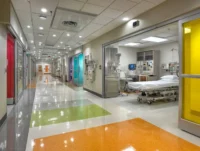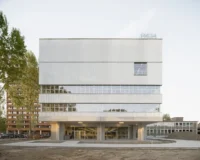Imagine building a home in days instead of months, with precision and minimal waste. Digitally fabricated homes are revolutionizing the way we think about construction. By combining advanced technologies like 3D printing and computer-aided design, we’re creating structures that are not only efficient but also sustainable and customizable.
This innovative approach to homebuilding offers endless possibilities. From reducing costs to addressing housing shortages, digitally fabricated homes are pushing the boundaries of what’s possible in architecture and design. As we embrace this shift, we’re unlocking a future where homes are tailored to our needs while being kinder to the environment.
What Are Digitally Fabricated Homes?
Digitally fabricated homes are structures built using advanced digital technologies like 3D printing, robotic assembly, and computer-aided design (CAD). These processes automate traditional construction tasks, leading to faster, more precise, and environmentally friendly homebuilding.
Key features include customized designs achieved through CAD software, additive manufacturing techniques such as 3D printing to create building components, and robotics for seamless assembly. Using these technologies minimizes material waste, streamlines construction, and reduces overall costs.
Unlike traditional methods, digitally fabricated homes allow for on-demand architectural customization. For example, walls, frames, or even entire sections can be prefabricated with exact specifications. This enables tailored designs for individual preferences while improving efficiency.
Through sustainable materials like biodegradable composites and efficient energy consumption during fabrication, these homes contribute to eco-conscious construction. Their scalability also addresses housing shortages by producing cost-effective units in shorter timeframes.

Technologies Behind Digital Fabrication
Digital fabrication integrates innovative technologies to revolutionize the construction of homes. These technologies enable faster, more precise, and sustainable building methods.
3D Printing
3D printing uses additive manufacturing to create building components layer by layer. It reduces material waste by precisely depositing material only where needed. For example, concrete 3D printers construct walls by layering cement mixtures, replacing traditional, waste-intensive techniques. This technology supports complex geometries, enabling more customization in home designs. Companies like ICON and Apis Cor have advanced large-scale 3D printing for affordable housing solutions.
CNC Milling
CNC (Computer Numerical Control) milling involves subtractive fabrication that carves materials like wood, metal, or synthetic composites into precise parts. This process uses digital CAD data to guide cutting tools, ensuring high accuracy and minimal errors. CNC milling is effective for components requiring intricate detailing. Customized wall panels and modular furniture are common applications. It complements other digital fabrication methods by providing precision-cut elements for seamless assembly.
Robotics and Automation
Robotics and automation streamline the assembly of digitally fabricated components, enhancing efficiency and consistency. Robotic arms perform tasks such as bricklaying, welding, and material placement with precision. Autonomous construction systems reduce labor dependency and significantly speed up project timelines. For instance, robotic bricklayers like Hadrian X can lay up to 1,000 bricks per hour, optimizing structural assembly processes. Integrating robotics promotes scalability for larger projects while maintaining accuracy standards.

Benefits Of Digitally Fabricated Homes
Digitally fabricated homes offer transformative advantages that redefine traditional construction. These benefits span cost savings, environmental impact, and construction timelines.
Cost Efficiency
Digitally fabricated homes reduce costs by streamlining construction processes. Advanced technologies like 3D printing require fewer materials by layering only what’s necessary, cutting waste and saving expenses. Robotic systems optimize labor usage, decreasing reliance on manual workers and lowering labor costs. For example, companies like ICON have demonstrated that 3D-printed homes can cost 30-40% less than conventional methods.
Sustainability
Digital fabrication promotes sustainability by minimizing material waste and supporting eco-friendly building practices. Construction waste, constituting 35% of landfill deposits annually, is drastically reduced through additive manufacturing techniques. Additionally, these homes enable the use of sustainable materials such as bio-concrete or recycled plastics, reducing the environmental footprint. Excess materials produced during CNC milling or robotic assembly are often recyclable, further supporting resource conservation.
Speed Of Construction
Digitally fabricated homes drastically shorten construction timelines. Robotic assembly and 3D printing operate continuously, enabling homes to be built in days instead of weeks. For instance, Apis Cor completed a 400-square-foot home in 24 hours using 3D technology. Automated precision avoids delays related to human error or adverse weather, making the process resilient and efficient.

Challenges in Digital Home Fabrication
Although digitally fabricated homes showcase numerous advantages, several challenges hinder their widespread adoption. Addressing these obstacles is vital to unlocking the full potential of this innovative approach.
Technical Limitations
Digital fabrication technologies face constraints in material diversity and structural capabilities. Additive manufacturing processes, like 3D printing, often rely on specific materials such as concrete mixes that may lack flexibility for certain geographic or climatic demands. Robotics used in assembly can encounter difficulties managing complex or unconventional designs, reducing their overall efficiency in non-standard applications. Additionally, hardware limitations in CNC systems or 3D printers can restrict scalability to larger projects, impacting production timelines for multi-unit developments.
Regulatory Hurdles
The regulatory landscape for digitally fabricated homes is still evolving, creating roadblocks in permits and compliance. Building codes vary regionally and often don’t accommodate non-traditional construction methods. For instance, ensuring structural safety for homes produced with automated technologies can involve lengthy approval processes. Zoning laws may also limit where these homes can be built, particularly in areas unfamiliar with advanced construction practices. Collaboration with policymakers and updates to codes will be critical in facilitating adoption.
Public Perception
Digitally fabricated homes often face skepticism due to misconceptions about quality and durability. Some individuals associate automated production methods with temporary, low-cost housing, which can deter interest or acceptance. Concerns surrounding aesthetic limitations or the lack of traditional craftsmanship further influence public opinion. Effective communication and education about the benefits, such as sustainability and customization potential, are essential to overcome these biases and build trust.

Notable Examples Of Digitally Fabricated Homes
Several projects worldwide have demonstrated the potential of digitally fabricated homes, showcasing innovation in construction, sustainability, and design efficiency. Below are key examples that highlight the advancements in this field.
Icon’s 3D-Printed Homes
Icon, based in the United States, has pioneered affordable housing projects using large-format 3D printing technology. Their Vulcan printer creates concrete structures layer by layer, producing homes with precise designs and reduced construction times. In 2020, Icon completed a community of 3D-printed homes in Mexico for families in need, offering durable and weather-resistant structures. Other projects, such as the 3D-printed homes in Austin, Texas, have demonstrated scalability, with homes blending automation and modern design.
Dubai’s 3D-Printed Office
Dubai introduced the world’s first fully functional 3D-printed office in 2016. The “Office of the Future” was built in just 17 days using 3D printing technology and cost-effective construction methods. The 2,700-square-foot building serves as an example of streamlined processes and eco-friendly materials. The structure integrated energy-efficient systems, showcasing how digital fabrication could revolutionize urban architecture. Dubai’s commitment to 3D printing aligns with its strategy to make 25% of all buildings 3D printed by 2030.
The Future House Project
The Future House Project in Beijing exemplifies how robotic assembly and advanced CAD designs can create highly customized, sustainable homes. The project integrates modular construction and eco-conscious materials to reduce waste and energy use. Robotic arms assemble prefabricated parts, enhancing speed and precision. These homes incorporate smart technology, merging digital fabrication with features like automated systems and energy-efficient designs. The project showcases futuristic yet practical solutions for housing challenges in urban environments.

Future Prospects for Digitally Fabricated Homes
Digitally fabricated homes are poised to evolve with continuous advancements in technology and growing interest from industries worldwide. These prospects highlight the potential to address global housing demands while maintaining efficiency and sustainability.
Advancements in Technology
Technological innovations are driving the next stage of digital fabrication. AI integration is enhancing precision in design processes, enabling algorithms to optimize structures for material efficiency and strength. Advanced materials such as carbon-reinforced composites and sustainable bio-based alternatives are expanding the range of possibilities for 3D-printed construction. Machine learning applications are improving automated assembly, minimizing errors, and streamlining construction timelines further. For instance, robotic systems with adaptive learning capabilities are being tested to construct multi-story structures more safely and efficiently.
Expanded 3D printing capacities are addressing structural limitations by allowing larger-scale construction and more diverse architectural designs. Hybrid systems combining additive and subtractive manufacturing are increasing versatility, enabling complex construction that incorporates precise detailing alongside large-scale production. These centralized improvements ensure that digitally fabricated homes remain competitive with traditional methods while elevating what’s achievable.
Potential for Mass Adoption
The potential for large-scale adoption of digitally fabricated homes is growing as costs decrease and awareness increases. The affordability of homes built with 3D printing, robotics, and CAD strategies is attracting developers, governments, and non-profits aiming to deliver housing at scale in regions facing shortages. For example, humanitarian projects like New Story’s initiatives in Latin America demonstrate the feasibility of 3D-printed communities for low-income populations.
Partnerships between construction tech firms and policymakers are facilitating updates to regulatory frameworks, simplifying the approval process for digital fabrication technologies. Public sentiment is gradually shifting as successful projects showcase durability, aesthetics, and cost savings. Pilot programs in urban hubs showcase how digital fabrication integrates with existing cityscapes, paving the way for mainstream acceptance.
Conclusion
Digitally fabricated homes represent a convergence of innovation, efficiency, and sustainability in construction. By leveraging technologies like 3D printing, robotic assembly, and CAD, these homes address pressing issues such as housing shortages, high costs, and environmental concerns. They enable precise, customizable designs while reducing material waste and construction timelines.
Although challenges like regulatory barriers, material limitations, and public perception exist, collaborative efforts and industry advancements are steadily overcoming these obstacles. The promising examples of projects worldwide illustrate the transformative potential of digitally fabricated homes to revolutionize housing. Advances in AI, machine learning, and material technology are paving the way toward broader adoption and accessibility.
- 3D printed homes
- advanced building techniques
- construction speed experts
- digital construction technology
- Digitally fabricated homes
- eco-friendly home building
- energy-efficient homes
- innovative construction solutions
- modern home fabrication
- precision construction techniques
- prefabricated homes
- rapid construction methods
- revolutionary construction methods
- Sustainable Architecture
- sustainable building solutions















Leave a comment